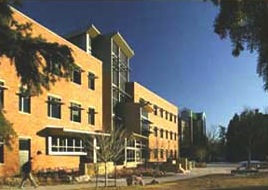Tutt Science Building
 The Russell T. Tutt Science Center was planned to give departments more space and adequate laboratories for teaching and research. It is home to the environmental science, mathematics, psychology, and neuroscience departments, along with part of geology.
The Russell T. Tutt Science Center was planned to give departments more space and adequate laboratories for teaching and research. It is home to the environmental science, mathematics, psychology, and neuroscience departments, along with part of geology.
The building houses "smart" classrooms (classrooms with technology that integrates multimedia resources such as the web, PowerPoint presentations, video and DVD into teaching), faculty offices, a lecture hall, as well as state-of-the-art laboratories. The building also meets the Leadership in Energy and Environmental Design (LEED) criteria for green building standards which include the use of recycled waste materials, certain levels of energy efficiency, and even bike racks and outlets for electric cars. See below for a listing of the green building features of the Tutt Science Building.
Green building standards were developed by the U. S. Green Building Council to promote innovative energy and environmental design practices. The Tutt Science center incorporates 26 of 52 points as determined by the LEED system (Leadership in Energy and Environmental Design). These points include:
| Sustainable Site | Indoor Air Quality |
|---|---|
|
|
| Energy and Air Pollution | Water efficiency |
|
|
| Materials and Resources | Additional Environmental Features |
|
|


